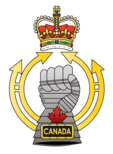
With Rome being declared an open city, the

With Rome being declared an open city, the
In order to support the Allied effort in Europe, combat hardened units were pulled from the Italian front to augment the forces in France.
The US VI Corps (Three divisions) and French Expeditionary Corp (four divisions) were moved to Europe to support Operation Dragoon - another amphibious assault to capture southern France. (Seven Divisions)
The seven divisions were replace by three: Brazilian 1st Div, US 92nd Div, and US 10 Mountain Div . Although the 10th Mountain would not arrive until January 1945.
This would later move the Canadian Forces as well as part of Operation Goldflake in February 1945.






Operation Ladbroke and Operation Fustian
 (Image: DEF Shoulder Patch) In early 1939, Brazil was expected to stay neutral as they had in 1914. Brazil had strong economic ties to Germany as well as a politically active German ex-patriate community. This caused the US and British governments to use diplomatic pressure to get Brazil (as well as other South American countries to cooperate with the allies and isolate Germany.
(Image: DEF Shoulder Patch) In early 1939, Brazil was expected to stay neutral as they had in 1914. Brazil had strong economic ties to Germany as well as a politically active German ex-patriate community. This caused the US and British governments to use diplomatic pressure to get Brazil (as well as other South American countries to cooperate with the allies and isolate Germany.
In January 1942, in exchange for economic assistance, Brazil severed diplomatic relations with German, Italy, and Japan.
In retaliation, 21 German and two Italian submarines sunk 36 Brazilian merchant ships, killing almost 2,000 people. On August 22 1942, within a week of the last U-boat attack, Brazil declared war against the Germany, Italy, and Japan. However, it was not until January 1943 that Brazil decided to send troops to aid in the war effort.
Brazil committed an Infantry Division as well as Air and Naval Assets to the Allied war effort.
The Brazilian Expeditionary Force (BEF) was made up of the Brazilian First Infantry Division (three Regimental Combat Teams of 5,000 plus logistics and support) and the First Fighter Squadron (48 P-47 D Thunderbolts) and the First Liaison and Observer Flight (12 L-4H Cubs). The Fighter Squadron was assigned to the US 12th Air Force and the Infantry and observer flight became part of the US 15th Army .
It took a further two years for the BEF to get equipped and trained.
The first Brazilian combat unit (6th RCT) landed in Naples on 16 July 1944. They landed without equipment and the US were not prepared for them. The first few weeks were spent in getting equipped and trained.
The BEF began with reconnaissance missions in August 1944. In September, their first successes were seen as they took the small towns of Massarossa, Camaiore, Monte Prano and the Serchio Valley. This was accomplished without major causalities.
They spent the winter of 44/45 at the northern base of the Apennines near Tuscany.
During the 1945 Spring offensive, the BEF (working with the US 10th Mountain Division) were able to capture Monte Castello and Castelnuovo which were key artillery positions for Germany/
The final offensive began on 14 April 1945 , the BEF led the US IV Corps and took the town of Montese and were able to defeat a German counter attack. German defeat in Italy was unavoidable.
On 25 April the Italian resistance movement started a general partisan insurrection at the same time as Brazilian troops arrived at Parma and the Americans at Modena and Genoa. The British 8th Army advanced towards Venice and Trieste.
At Collecchio, BEF forces captured more than 13,000 men, including the entire 148th Infantry Division, elements of the 90th Panzergrenadier and the Italian 1st Bersaglieri "Italia" Division.
In their final advance, the Brazilians reached Turin and then on 2 May they joined up with French troops at the border in Susa. That same day brought the announcement of the end of hostilities in Italy.
The BEF did not go to Europe but did briefly serve in occupation duties in Italy. It was recalled to Brazil at the end of 1945 and dissolved.
BEF losses were approximately 1,000 dead and 4,300 wounded.

By using this site, you agree to our terms and conditions.
Terms and Conditions.
Copyright
Contact us by email.
© 2020 Royal Canadian Armoured Corps Association
